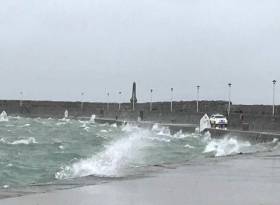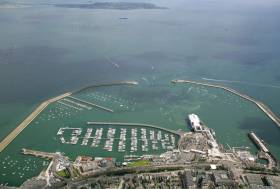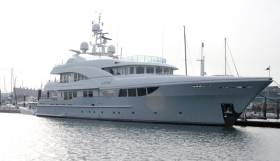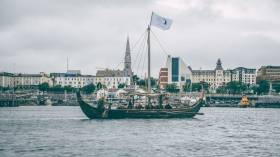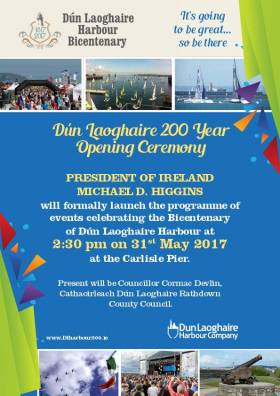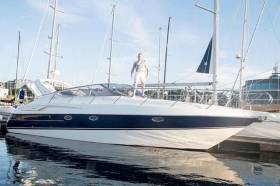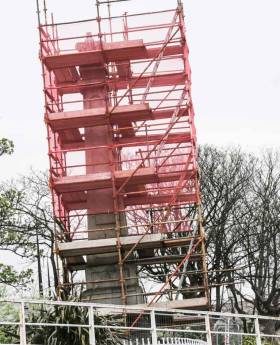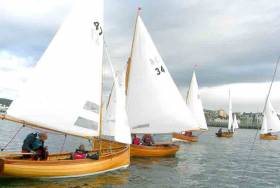Displaying items by tag: Dun Laoghaire Harbour
Storm Brian Hits Dun Laoghaire: Optimist Dinghies & Sailing Cruiser End Up On Harbour Walls
Storm Brian's strong north–westerly winds, gusting over 40–knots, left both a training group of Optimist sailors and at least one moored cruiser on Dun Laoghaire harbour wall this lunch time.
Eyewitness reports say that four Optimist dinghies were 'abandoned' in the squall at the East Pier. The eyewitnesses say the junior sailors involved are safe and accounted for.
Dangerous situation in @dunlaoghaire harbour averted after sailors rescued from small boats overcome by wind & waves #stormbrian #rtenews pic.twitter.com/sKN0rTT2HL
— Joe Mag Raollaigh (@joemagraollaigh) October 21, 2017
In a separate incident, in what appears to be case of broken ground tackle, a sailing cruiser ended up on the West Pier earlier this morning.
 A launch attends to a sailing cruiser lying up against the West Pier wall at Dun Laoghaire
A launch attends to a sailing cruiser lying up against the West Pier wall at Dun Laoghaire
Water Temp:13.8 °C, Avg Wind:29kts, Gust:42kts, Wind Dir:290 °(W), Gust Dir:302 °(NW), Wave Height:0.9m at 21/10/2017 14:29:00
— Dublin Bay Buoy (@DublinBayBuoy) October 21, 2017
The incidents have prompted a statement regarding today's on the water activities from the Irish National Sailing & Powerboat School Chief Instructor & Director, Kenneth Rumball:
'The Irish National Sailing & Powerboat School cancelled most of it on the water activities due to the adverse weather forecast for Saturday the 21st October 2017.
We had a small number of our brightly colored craft on the water for a very short period of time on Saturday morning.
A small number of powerboat clients were operating in a very well sheltered area of the inner harbour for a time also this morning.
Knowing the weather was due to hit later that morning, all clients, staff and personnel were off the water once the worst of the westerly winds started to hit.
None of the craft in the videos and pictures circulating the internet from Dun Laoghaire Harbour are craft belonging to the Irish National Sailing & Powerboat School'.
The centre of #StormBrian is now over Dublin pic.twitter.com/hj3L6SMgwU
— Met Éireann (@MetEireann) October 21, 2017
Update here.
Without a Harbour Czar, Dun Laoghaire’s All at Sea
Other cities are developing their waterways in imaginative ways but Dublin still can’t get it right writes David O'Brien.
Take the DART out to Dun Laoghaire today and on arrival at the station, the Iarnród Éireann announcer says: 'Dun Laoghaire - change here for ferry services.' Except from 2011 only a seasonal car ferry operated around Christmas time, and from 2015 there has been no car ferry at all. It's a small detail that reveals how disconnected the harbour has become.
Back in 2011, an artist's impression envisaged a regenerated Dun Laoghaire harbour with a cruise berth, an urban beach and a 'flotel'.
 An Artist's impression of the harbour published by the Harbour Company in 2011
An Artist's impression of the harbour published by the Harbour Company in 2011
Six years later, many say such fanciful notions are all washed up. The harbour remains empty of commercial shipping. The new harbour owners, Dun Laoghaire-Rathdown County Council, are dragging their feet on what's next. Hardly befitting of the harbour town's bicentenary year, is it?
What's more, as if to symbolise how bereft of marine ideas the State harbour company has become, last month's latest attempt to cash in on the country's housing crisis with – wait for it – waterborne homes is set to run foul of existing harbour users.
But that latest slip-up is a drop in the ocean compared to the overall problems facing the great granite harbour. Dun Laoghaire's waterfront is a national monument but also a monumental challenge.
The hope, of course, it that the just-released plan of converting the old ferry terminal into office space can at least bring some life to the port.
Two Dublin-based businessmen are reported to be investing up to €20 million in the former ferry terminal to create 'a hub for technology, marine and design businesses'. It shows a new and enlightened approach by the Dun Laoghaie Harbour Company to using the vacant space which, it is claimed, could bring up to 1,000 people into the harbour area.
Creating office space is one thing; stimulating the market to create marine jobs is quite another.
Yet harbour stakeholders should do all they can to support what sounds like a positive move, because until now the only thing to show for the doomed 'master plan' is the removal of the sheds on Carlisle Pier, a cruise line debacle that has pit neighbour against neighbour and run up an estimated €2 million in consultancy fees. What is arguably the town's biggest asset is still being treated as a white elephant. After all the money spent on the masterplan, not one sod of turf has been turned.
The best suggestion that the harbour's primary users can come up with is hardly adequate, either. In the absence of a suitable paying tenant, boaters are saying the State will just have to foot the bill for harbour maintenance, 'just like they do for the Phoenix Park'.
Others have mooted, is that a bill worth footing? The purpose for which Dun Laoghaire Harbour was built is no longer required, so would it be cheaper to knock it down than maintain it? That's just one of the outlandish comments circulating in the south Dublin town due to the state of flux at Ireland's biggest boating centre.
Bizarre things have happened before. For example, in 1995, Dun Laoghaire Harbour Company filled in over 15 acres of the harbour to facilitate the construction of a new berth for the 'revolutionary' Stena HSS ferry. It was a move that gave the Swedish ferry company a monopoly in the port because no other ship could use the specially constructed mooring. Today, just 25 years later, Stena is gone, the HSS is gone, the berth is gone – but 15 acres of the harbour's precious waterspace remain filled in.
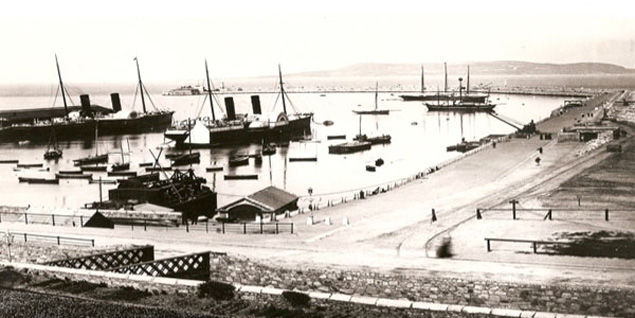 Dun Laoghaire Harbour in its heyday, a vibrant ferry port. For more than 170 years a 'mail boat' service travelled between Dun Laoghaire and Holyhead in Wales. Even during World War I the mail boat sailed, and it continued uninterrupted service until the mid 1970s. The new car ferry terminal was completed in 1969 and the ferry service, boosted in the 1990s by the HSS fast ferry, operated here until 2015
Dun Laoghaire Harbour in its heyday, a vibrant ferry port. For more than 170 years a 'mail boat' service travelled between Dun Laoghaire and Holyhead in Wales. Even during World War I the mail boat sailed, and it continued uninterrupted service until the mid 1970s. The new car ferry terminal was completed in 1969 and the ferry service, boosted in the 1990s by the HSS fast ferry, operated here until 2015
It’s obvious to all now that there's no silver bullet for Dun Laoghaire Harbour. Any hope rests, as it always did, in marine-related projects that can take advantage of the giant structure’s original intention. It needs someone with the gravitas, business nous, but most of all passion for the harbour that can turn the tide on its future.
Sounds like a tall order? Yes indeed, except that exact scenario is already playing out at another port in Ireland.
No viable plan for harbour's future
One of the problems is that the State is looking at the harbour only as built infrastructure: a site to cash in on, rather than a place with massive amenity value.
Public representatives have roundly criticised the harbour company on many fronts, but equally, is it not unfair to ask that company to produce an amenity plan when it is not charged to do so?
With 1.5 million people living on its doorstep, resulting in significant demand for marine leisure facilities, it is to our shame that there is no viable plan for Dun Laoghaire Harbour's future.
Dublin's proud boast is that it now offers not one but two world-class sports arenas in Croke Park and the Aviva Stadium. For decades to come, millions of fans will be entertained in the facilities, a tribute to the vision of the men and women who pushed for their development.
But these are not the biggest sports arenas in Dublin. That distinction goes to another site that now needs a generous amount of vision and development: Dublin Bay.
 Dun Laoghaire Harbour is the gateway to the city's playground, Dublin Bay. The seaside town comes complete with a unique harbour, world-class yacht clubs and transport links, all just six miles from Grafton Street. Photo: Michael Chester
Dun Laoghaire Harbour is the gateway to the city's playground, Dublin Bay. The seaside town comes complete with a unique harbour, world-class yacht clubs and transport links, all just six miles from Grafton Street. Photo: Michael Chester
Dublin's stadiums normally feature 30 people on the field of play. In Dublin Bay, that number runs into the thousands. Dun Laoghaire Harbour is, in effect, the gateway to the city's largest sports ground.
Every weekend, the area of water between Howth Head and Dalkey is filled with sailors, divers, swimmers and fishermen, to say nothing of the hordes that simply run or walk by its shores. This resource is unique: no other European capital has this kind of natural sports amphitheatre on its doorstep.
But Dun Laoghaire, one of the world's largest man-made harbours. now faces a massive challenge. And how it is addressed may well hold the key to whether or not Dublin becomes a true capital of sport.
The harbour could be a major European marine activity centre, encompassing a variety of marine activity both commercial and leisure, including maritime research and oceanography. What's required is a vision to shape this harbour for the next 200 years and let the people of Dublin push the boat out.
People should be able to use the harbour as an active facility, and it must be possible for them to do more than just walk on its piers.
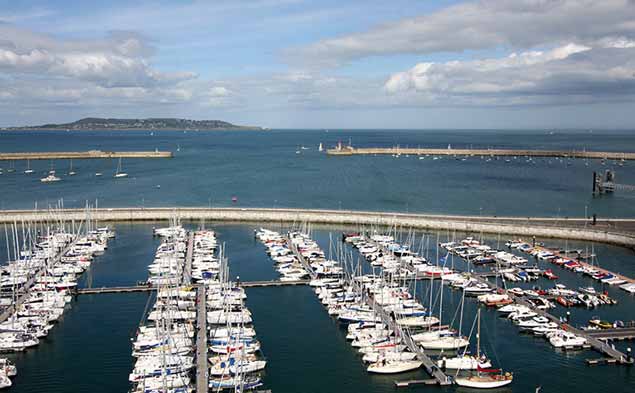 The high cost of pleasure craft berth rental rates paid to the harbour company are crippling marine leisure growth at Dun Laoghaire marina, the country's biggest boating centre
The high cost of pleasure craft berth rental rates paid to the harbour company are crippling marine leisure growth at Dun Laoghaire marina, the country's biggest boating centre
Amazingly, however, Dun Laoghaire Harbour Company offers almost no maritime activity that engages the general public, even though it is landlord to the country's largest marina – a state-of-the-art facility – and collects rent from 500 private boat owners.
It has lost its anchor tenant and has not replaced it. It is about to be taken over under new legislation and run by the local county council. Whatever official structure eventually lays claim to it will require marine expertise to properly engage with its original intention: marine use.
Instead of looking at the harbour as a site to be exploited commercially (for which, read ‘apartments’) those in charge should look for new ideas by creating a waterfront forum, with the local yacht clubs and the existing commercial operators, to promote the harbour's massive potential for high-yield marine tourism, at the very least.
There are real benefits in this, particularly for the neighbourhood. For example, the country's largest sailing event, the Volvo Dun Laoghaire Regatta, held in the harbour biennially since 2005, generates €3 million in revenues for the town. But it's not just a regatta, it's a rolling manifesto of what Dun laoghaire sailing could achieve if it pulled together.
It has been a long-standing criticism that the town centre is physically disconnected from the harbour by the railway line that runs in front of it. The council is completing cover-over sections of the line, a move to encourage more people down to see what's happening on the water, and this cannot come soon enough.
With such investment, it should be possible for local retailers – a sector in decline in the town, which, in recent times, has seen one in five shops boarded up – to pitch at the needs of the harbour and visiting ships. That was always the hope if plans to attract cruise liners had come off, but what's also required is to develop the sort of jobs that cannot be shipped abroad.
Think of the Pfizer plant in Dun Laoghaire; the cost to the Exchequer of each of those 210 or so jobs and the ease with which they upped and left. For a similar investment, we could have developed 200 jobs that would stick to Dun Laoghaire like limpets because this is where their natural advantage would exist.
These employers would not be in the old-style hunter-gatherer lifestyles (eg inshore or sea fishing) but in activity tourism and niche manufacturing and services.
As a working 'for instance', a sail making firm was established in Crosshaven, Co Cork in 1974. It's still there, a thriving small Irish business that designs and exports sails all over the world. It grew thanks to the enterprise of a local initiative by Royal Cork Yacht Club to develop festivals and events such as the world-renowned Cork Week regatta.
Dun Laoghaire has no such marine cluster. Derelict harbour buildings could be used as incubators for sailmakers, riggers, marine electronics and mechanical workshops. These businesses already exist but in a small way, currently employing up to 100 people, most of whom work out of vans without proper premises.
Dun Laoghaire is falling behind
In spite of Dun Laoghaire Harbour's position as the largest boating centre, it is now falling way behind other Irish ports. Dun Laoghaire sailing interests also need to set out a stall for the future.
The East Pier is a golden opportunity for a regulated commercial activity, but this potential is limited by the absence of services on the pier such as adequate water supply and power outlets. Major work was carried out on this pier in the past few years, but services were ignored.
Another opportunity is an adequate landing stage. The experience of other ports with cruise liner traffic is that once the big ships arrive, smaller ones usually follow. There is a market for super yacht/mega yacht boats. These were calling and using the Dublin City Mooring facility on the River Liffey until it was closed, and have now mostly stopped calling to the East Coast altogether.
A suitable landing stage could also be used for events such as boat shows, all centred around the Carlisle Pier.
In addition, there are currently no opportunities for the general public to try sailing or boating without having to take a sailing course or join a club. The French system of publicly owned boats available to hire at a small cost allows easy sailing opportunities for schools and the general public.
And it's a system that could be successfully transferred to Dun Laoghaire because, against the odds, a commercial sailing school manages to operate in the harbour without any State support and many obstacles.
Research, and the experience in France and elsewhere, points to the need to establish a maritime activity centre as hub to nurture new marine businesses.
Investing in the harbour in this way could allow Dun Laoghaire to provide an ideal base for tall ships to winter and do regular maintenance. There is only one small area given over to boat yard activities in Dun Laoghaire, yet there are over 1,000 boats based in the harbour.
By allowing the expansion of yard facilities, a fully-functioning boat yard could provide full-time employment for a large number of people.
In the move from commercial port to leisure harbour, the combined marine leisure groups – such as the well-established yacht clubs with over 5,000 sailors, the maritime museum, marine trade and other users – could band together and move forward as a united users group rather than competing interests.
One example of this is the staging of a national maritime festival along the lines of SeaFest, first staged in Cork Harbour in 2015 and now an annual fixture in Galway.
In July 2010, Dun Laoghaire Rathdown County Council spent over €1m on the Festival of World Cultures. The budget figure overran by €400,000. If this level of funding is available, surely the town's maritime culture could feature, too? After all, this is the council that found €36m to build a library to overlook the harbour in the teeth of recession.
It would be an ideal opportunity to put to good use the new 8,500 sqm space presented by Carlisle Pier, the country's only exhibition space in the middle of the sea.
If that sounds like pie in the sky, it really shouldn't seem so far out of reach, as it’s this kind of thinking that’s going on elsewhere in the country.
In Cork Harbour, a politician there who can see the potential in the blue economy has been pushing buttons to promote maritime interests.
Minister for Foreign Affairs Simon Coveney, a sailor and a former Minister for the Marine, has been instrumental in securing significant marine funding to develop the €20 million Beaufort Centre. It’s the final piece of a jigsaw that makes Cork Harbour a world-renowned marine research and development location, helping to unlock Ireland's maritime and energy potential.
It's been the same in Galway, where the Marine Institute is based and has developed world-class marine expertise. These efforts have come about under the stewardship of John Killeen, chair of the institute and an experienced sailor.
Coveney and Killeen are 'harbour czars', passionately and cleverly pushing the maritime agenda because they can see how it can benefit the local and national economies.
So where is Dun Laoghaire Harbour's world class marine research centre? Where is Dun Laoghaire Harbour's slice of the Government marine budget pie? Where is Dun Laoghaire Harbour's czar?
#Superyachts - All indications show the superyacht market is turning around — and as it expands, it’s important to note that more and more of these vessels are eschewing crowded Mediterranean spots and cruising instead in Northern European waters.
Typically these luxury craft, many greater than 50 metres in length, are heading to northern destinations such as the Orkney Islands, Norway and Sweden that are already popular with cruise liners.
On the way, they’re transiting the Irish Sea — and seeking opportunities for safe and convenient berths close to transport links in the UK and Ireland alike. Dun Laoghaire is perfectly positioned to capitalise on this market.
 The completion of the Samuel Beckett Bridge across the River Liffey in Dublin City effectively meant the demise of the Dublin City Mooring facility in 2010 as large craft could no longer transit the river. During their relatively short period of operation, the modest Dublin City Mooring pontoons in the heart of Dublin was able to attract a number of superyachts (like the Triple 7 above) to berth on their pontoon which was located conveniently in the heart of Dublin. This is no longer possible and has effectively ended Dublin as a destination for visiting superyachts but these superyachts still want to come here
The completion of the Samuel Beckett Bridge across the River Liffey in Dublin City effectively meant the demise of the Dublin City Mooring facility in 2010 as large craft could no longer transit the river. During their relatively short period of operation, the modest Dublin City Mooring pontoons in the heart of Dublin was able to attract a number of superyachts (like the Triple 7 above) to berth on their pontoon which was located conveniently in the heart of Dublin. This is no longer possible and has effectively ended Dublin as a destination for visiting superyachts but these superyachts still want to come here
Above and beyond the local spend on overnight berths, and victualling these superyachts, there are significant opportunities to target high net worth individuals in the luxury tourism market. And Dublin is a recognised go-to destination.
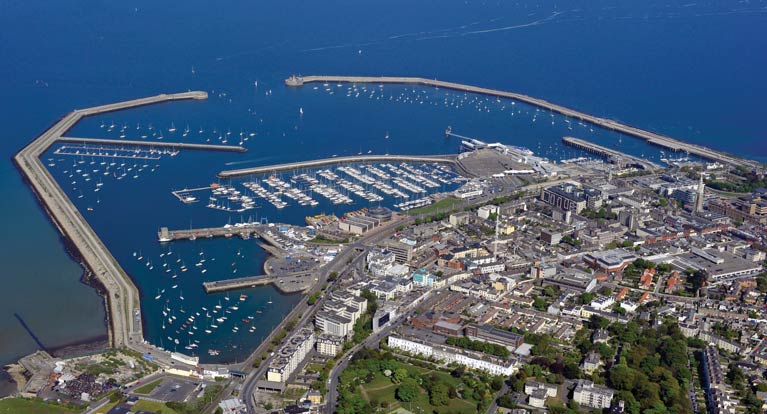 The Dun Laoghaire Harbour Company is currently marketing the harbour as a cruise ship destination in competition to the existing location of Dublin Port. It is seeking to establish the harbour as a stop over for small to medium sized cruise ships and has identified the Carlisle Pier for this purpose. Super yachts can also be accomodated in this plan. Photo: Michael Chester
The Dun Laoghaire Harbour Company is currently marketing the harbour as a cruise ship destination in competition to the existing location of Dublin Port. It is seeking to establish the harbour as a stop over for small to medium sized cruise ships and has identified the Carlisle Pier for this purpose. Super yachts can also be accomodated in this plan. Photo: Michael Chester
Many of these superyachts are the size of small ships, weighing over 250 tonnes. It means they’re too big for Dun Laoghaire’s 800–berth yachting marina, but they represent a welcome boon for a harbour vacant since the loss of the Stena HSS ferry service. One recent arrival into Dun Laoghaire was the magnificent Atlantic schooner from America in August. Read Aflaot.ie's article on the Atlantic's visit here.
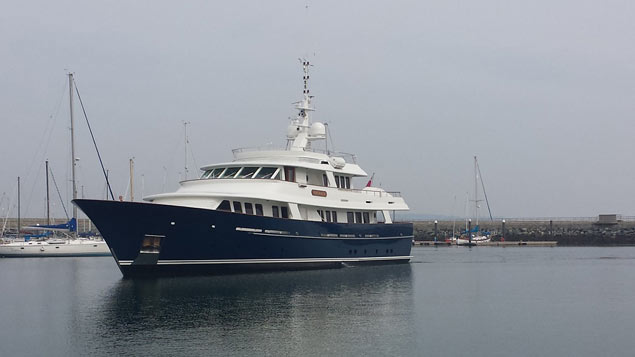 The 35.80m Arcadia berthed in Dun Laoghaire in September 2014. Not only does the impressive 'Arcadia' have gorgeous lines but as the 159th vessel to transit the Northwest Passage, she's also a serious long distance expedition motor yacht too
The 35.80m Arcadia berthed in Dun Laoghaire in September 2014. Not only does the impressive 'Arcadia' have gorgeous lines but as the 159th vessel to transit the Northwest Passage, she's also a serious long distance expedition motor yacht too
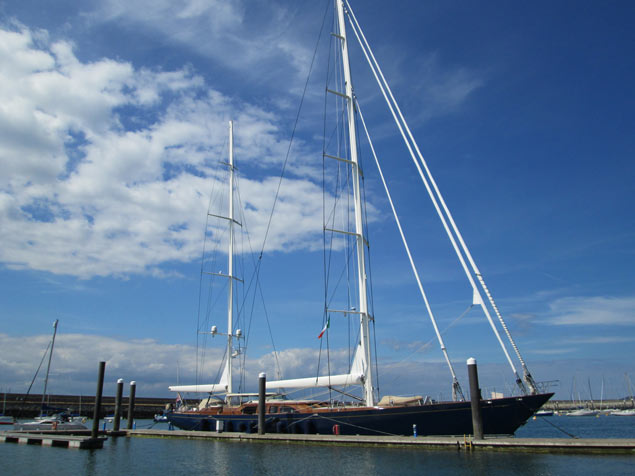 Even seasoned observers were gobsmacked at the sheer size of the 46–metre (150–foot) Superyacht Christopher berthed at Dun Laoghaire marina in 2014, dwarfing all 500 local craft in the harbour. Christopher represents the upper limit of craft permitted at the marina due to weight and draft restrictions. In fact Christoper could only be facilitated in the marina due to the fact she has a lifting keel
Even seasoned observers were gobsmacked at the sheer size of the 46–metre (150–foot) Superyacht Christopher berthed at Dun Laoghaire marina in 2014, dwarfing all 500 local craft in the harbour. Christopher represents the upper limit of craft permitted at the marina due to weight and draft restrictions. In fact Christoper could only be facilitated in the marina due to the fact she has a lifting keel
What's more thanks to the Failte Ireland accredited marina, it has the type of 'concierge' facilities to deal with visiting superyachts: everything from car hire to hotel bookings.
But this isn't an overture for billionaires who have no place to park their superyacht. There's a business case to say that Dun Laoghaire town can easily take advantage of this.
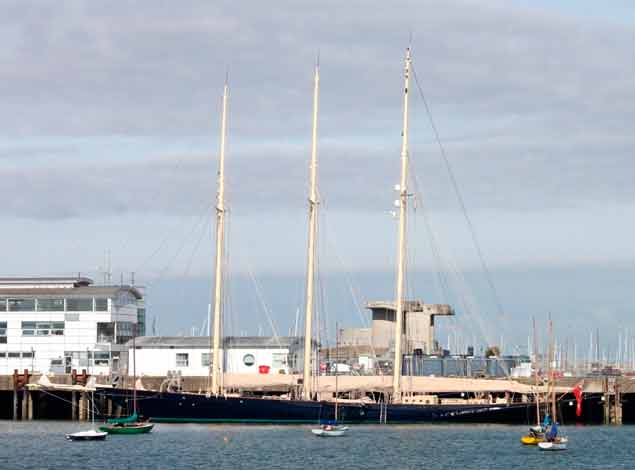 The two-year-old 185–ft three-masted schooner Atlantic alongside at Dun laoghaire Harbour in August. The replica that was too big for the yachting marina stayed for a week at a secure but somewhat neglected (below) berth No.4 alongside at the abandoned ferry terminal. Photos: Twitter
The two-year-old 185–ft three-masted schooner Atlantic alongside at Dun laoghaire Harbour in August. The replica that was too big for the yachting marina stayed for a week at a secure but somewhat neglected (below) berth No.4 alongside at the abandoned ferry terminal. Photos: Twitter The facilities required to operate a Super yacht berth amenity are relatively few. A serviced, heavy duty linear concrete pontoon of approximately 80–100m length with shore access via a bridge. Secure access by crew, guests and staff only. Crew facilities could be located in the ferry terminal and be accessible 24 hours to include toilet and shower facilities and wifi access. There is an existing level of security infrastructure which would be utilised including CCTV and Harbour Police to give added assurance to crew and guests that their boat will be secure at all times
The facilities required to operate a Super yacht berth amenity are relatively few. A serviced, heavy duty linear concrete pontoon of approximately 80–100m length with shore access via a bridge. Secure access by crew, guests and staff only. Crew facilities could be located in the ferry terminal and be accessible 24 hours to include toilet and shower facilities and wifi access. There is an existing level of security infrastructure which would be utilised including CCTV and Harbour Police to give added assurance to crew and guests that their boat will be secure at all times
At a time when nothing seems to be going right for Dun Laoghaire, these boats could be an important part in the mix of rejuvenating the harbour, bringing much needed revenues — and a splash of glamour.
They’re coming here already, but more could be done to market Dun Laoghaire as a superyacht destination that could even see the harbour as a winter lay-up hub, too.
To attract them would not need consultants, planning permission, investment, tenders — just the space they need. And that’s already available in Dun Laoghaire, which has four vacant ship berths capable of accommodating such vessels.
The question isn’t whether Dun Laoghaire can attract this lucrative superyacht business — the question is, who in the harbour will take the initiative?
 Source: Towergate Insurance
Source: Towergate Insurance
Battle of Dun Laoghaire Harbour Fought By INSS Viking Invaders
Out of the mist and rain came waterborne Vikings to battle on Dun Laoghaire's East Pier yesterday afternoon. The Irish National Sailing School (INSS) co-ordinated a free and family–friendly event that featured battles, longboats and a Viking village from 12-5pm.
Like a thousand years ago, the marauding did not commence on time. Downpours, however, did not deter an impressive crowd of hundreds, huddled together at the town's bandstand. By battle–time there was a steady stream of people on the pier's top level. Some locals even took it upon themselves to intercourse with invaders. Others were more focussed on the fight.
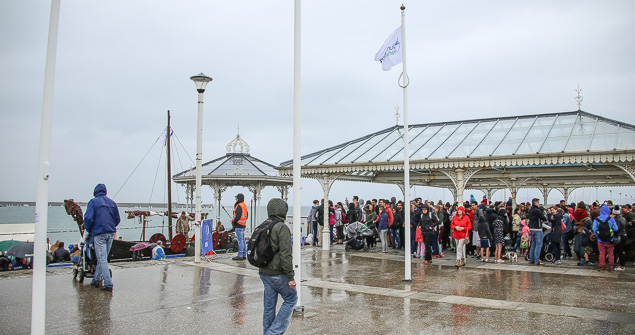 Local forces take shelter Photo: Afloat.ie
Local forces take shelter Photo: Afloat.ie
 Taking time for some Viking selfies before battle commences Photo: Afloat.ie
Taking time for some Viking selfies before battle commences Photo: Afloat.ie
 The Norsemen soon set up shop Photo: Afloat.ie
The Norsemen soon set up shop Photo: Afloat.ie
 Some were friendly....Photo: Afloat.ie
Some were friendly....Photo: Afloat.ie others maybe not so much...Photo: Afloat.ie
others maybe not so much...Photo: Afloat.ie
 INSS's Alistair Rumball prepares for battle as Viking longships approach from the harbour mouth Photo: Afloat.ie
INSS's Alistair Rumball prepares for battle as Viking longships approach from the harbour mouth Photo: Afloat.ie
INSS's Alistair Rumball, who provides Marine Film Location Services to the hit TV series Vikings, has been blamed for the Norse incursion.
His unlikely alliance with harbour forces including, King of Dun Laoghaire Harbour Gerry Dunne, led to the pitting of seafarers versus townspeople on the occasion of the harbour's bicentenary.
 The Irish summer was no deterrent to the planned invasion Photo: Afloat.ie
The Irish summer was no deterrent to the planned invasion Photo: Afloat.ie
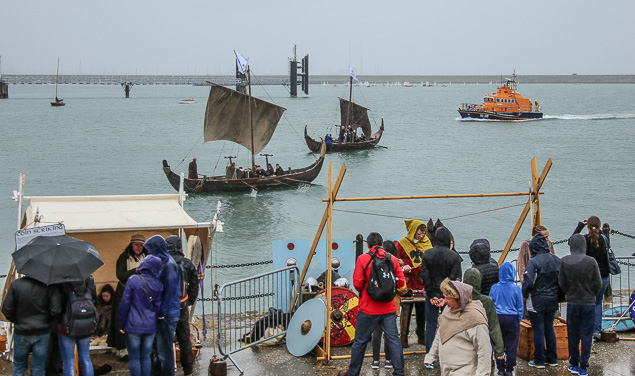 Not even the local lifeboat could stop it...Photo: Afloat.ie
Not even the local lifeboat could stop it...Photo: Afloat.ie
The onset of bad weather though, meant the Vikings, who approached under oar and sail, arrived early at the harbour mouth (Battle of Clontarf, here we go again) and Chief Rumball decreed battle should commence by 2pm.
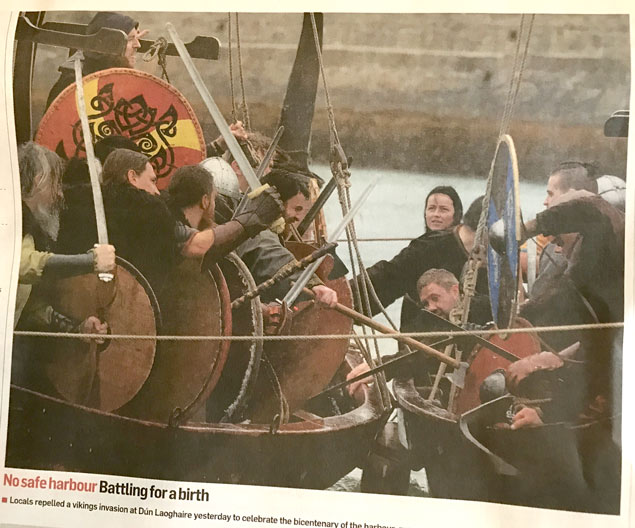 Making the press: Dun Laoghaire's Viking battle hit the headlines, including this fine photograph in this morning's Irish Times
Making the press: Dun Laoghaire's Viking battle hit the headlines, including this fine photograph in this morning's Irish Times
The battle was shorter than in Clontarf's sunrise to sunset exaggerated affair, but ended all the same in a rout of the Leinster forces that was witnessed by the High Chief of Leinster, Mary Mitchell O'Connor TD, Minister of State at the Department of Education.
The Viking contingent led by Sigurd Stena Line of Orkney and Brodir Irish Ferries of Mann were soon back in charge of the Piers – to the relief of many.
#HarbourTours – Following the recent visit of President Michael D Higgins to launch the Dun Laoghaire Bicentenary Celebrations, guided walking tours of the harbour continue to mid-June.
The free guided walking tours will delve into the magnificent engineering of the historic harbour that began construction 200 years ago in 1817. Four years later the harbour works were inspected by King George IV and following the visit the town was renamed Kingstown in his honour.
In 1823 along the harbour waterfront, the King George IV Obelisk monument was erected and this is where President Higgins on Wednesday last had attended the commemorative ceremony.
The talks will also explain about the earlier harbour and how the present harbour was built using granite from Dalkey.
Also the tour highlights some of the lesser-known features of this wonderful harbour, that was originally planned as a 'Port of Refuge' with just a single pier, the East Pier. It was decided however to add a second pier, that been the West Pier. In total the harbour took 25 years to construct with completion finally taking place in 1842.
Tours are held every Tuesday and Thursday until 15 June and are wheelchair accessible.
Meeting point: Bridge over the Dun Laoghaire DART Line at Crofton Road.
Time: 11.00am (1 tour per day)
Duration: 1 hour
Max Capacity: 30 people
The talks are part of the Spring into Heritage (28 April-18 June) programme organised by Dun Laoghaire-Rathdown County Council. For further website information including other events (click to download brochure) that are mostly free, it is advisable to arrive early.
#DLHarbour - Here’s a reminder for your calendar that President Michael D Higgins will officiate the opening ceremony of Dun Laoghaire Harbour’s bicentenary celebration.
President Higgins will formally launch the programme of events celebrating the harbour’s 200 years — which includes July’s Volvo Dun Laoghaire Regatta — from 2.30pm this Wednesday 31 May at Carlisle Pier.
The commemoration will be followed at 3pm by a 21-gun salute from the East Battery as well as a fly-past by two Air Corps aircraft from the direction of Killiney Hill, as previously reported on Afloat.ie.
#Notorious - MMA superstar Conor McGregor swapped the UFC Octagon for a sleek motor yacht to make the most of Ireland’s recent sunny spell, as his Instagram account indicates.
McGregor drove out to Dun Laoghaire Harbour a few days ago with a pair of jet skis hitched behind his “custom built” SUV to mess about on his latest extravagant purchase, a motorboat he’s named The 188 in a wry reference to the weekly Jobseekers Benefit.
True to his cheeky form, McGregor dismissed his new vessels as “summer toys” and jokingly offered: “Anyone wanna buy a yacht and a few skis hahaha [sic]”.
While the sun might be hidden again for a few days, Ireland is bound to get another mini-heatwave that will surely bring the ‘Notorious’ one back to Dun Laoghaire for more cruising in his inimitable style.
Two hundred years after the foundation stone was laid to build Dun Laoghaire Harbour, the President Michael D Higgins, accompanied by his wife Sabina, will officiate at the Bicentenary opening ceremony at 14:30 on Wed 31st May 2017, at the King George IV monument in Dun Laoghaire harbour.
In May 1817, the Lord Lieutenant of Ireland, Earl Whitworth, laid the foundation stone, the first stone from the quarry at Dalkey, on the site where the King George IV monument on Queens Road was subsequently built. On that day, Lord Whitworth, included with the foundation stone, a time capsule which included a coin of the realm and ten newspapers.
In the Bicentenary opening ceremony, to mark this special occasion two hundred years later, His Excellency, President Michael D Higgins, will place a new time capsule at the King George IV monument. This time capsule will include drawings from local school children, a newspaper of the day, recent photographs of the harbour, and letters from the RNLI, Coast Guard, Coal Harbour Users Group and An Cathaoirleach.
As part of the ceremony on May 31st next, the Air Corps will undertake a “Fly By”, ceremonial cannons will be fired, and a 21 Gun Salute will be accorded by the Irish Defence Forces to mark the occasion. Volunteers from the RNLI and the Coast Guard will create a guard of Honour to welcome the President.
The ceremony will also announce the packed summer schedule of events marking the Bicentenary of Dun Laoghaire harbour, taking place around Dun Laoghaire throughout the rest of the year.
Yesterday evening the Water Wags raced for the Buckingham Cup & Wigham Trophy with handicaps applied at the start, resulting in some boats starting five and a half minutes ahead of others. The handicaps were allocated on the basis of average finishing places in the three championship races held to date. At the time when the first boats started, there was almost no wind in that part of the harbour, and the course was laid for the expected wind from the east, and there was much congestion and dirty wind in the starting line area. The start guns sounded at approximately one minute intervals, but due to lack of wind many boats failed to start on their allocated times.
At the first mark, Paul & Anne Smith in Sara led from Ben McCormack in Marcia and Nandor with Brian Mc Bride and Stuart McBean sailing in 5 knots of wind. These three managed to escape the wallowing at the start area, and built up a huge lead. On the downwind legs, there was much effective blanketing in the following fleet caused by spinnakers of the following boats.
On the final beat, a large black cloud was building up over Dublin City. Eventually, the wind caused by this cloud revealed itself as a strong southerly wind of about 12 knots which hit some of the fleet with such a surprise, that a few boats nearly capsized.
At the finish the order was:
1st – 30, Sara, Paul & Anne Smith.
2nd - 45, Mariposa.
Cathy MacAleavey & Con Murphy
3rd.-33, Eva,
Orla Fitzgerald & Katie Tingle.
4th. 38, Swift, Guy & Jackie Kilroy
5th. - 44, Scallywag. Dan O’Connor & David Williams
6th. -15, Moosmie, David MacFarland.
7th. - Skee, Jonathan & Carol O’Rourke.
8th. - 31, Polly. Richard Mossop and Henry Rooke.
9th. – 46, Mademoiselle.
10th. –37, Marcia.
11th- 36, Little Tern.
12th. – 41, Mollie.
13th. -42, Tortoise,
14th. – 16, Penelope.
15th. - 18, Good Hope.
16th. -3, Pansy,
17th. – 4, Vela.
18th. – 40, Swallow.
19th. -43, Freddie.
20th. -47, Peggy.
21st. -20, Badger.
22nd. –26, Nandor.
23rd. -17, Coquette,
24th. -10, Sprite,
25th. - 34, Chloe,.
26th. -6, Mary Kate
Luxury Cruise Ship 'Serenissima' Arrives at Dun Laoghaire, The First of Eight Liner Visits For Harbour Town This Summer
The arrival of the five star luxury cruise ship Serenissima into Dun Laoghaire this morning kicks off the town's summer cruise-liner visits this morning.
Weighing in at over 2,500 tonnes, the Serenissima is the length of a soccer pitch, has 59 cabins and a passenger and crew complement of 160 people, will call today, allowing its passengers and crew take in the sights of Dun Laoghaire and surrounds.
Welcoming the ship into Dun Laoghaire, Carolyn Hanaphy of Dun Laoghaire Harbour Company said today that “the Serenissima is the first of 8 cruise ship visits scheduled for Dun Laoghaire this summer, bringing with them nearly 3,000 passengers and crew into the town. We are always delighted to see these ships come to our town and spend some time here. Each of these ships is welcomed alongside the historic Carlisle Pier leaving disembarking passengers and crew just 500 metres from the town centre where they can enjoy all that Dun Laoghaire offers in terms of hospitality, shopping and good restaurants and pubs all within a short stroll from the ship.”
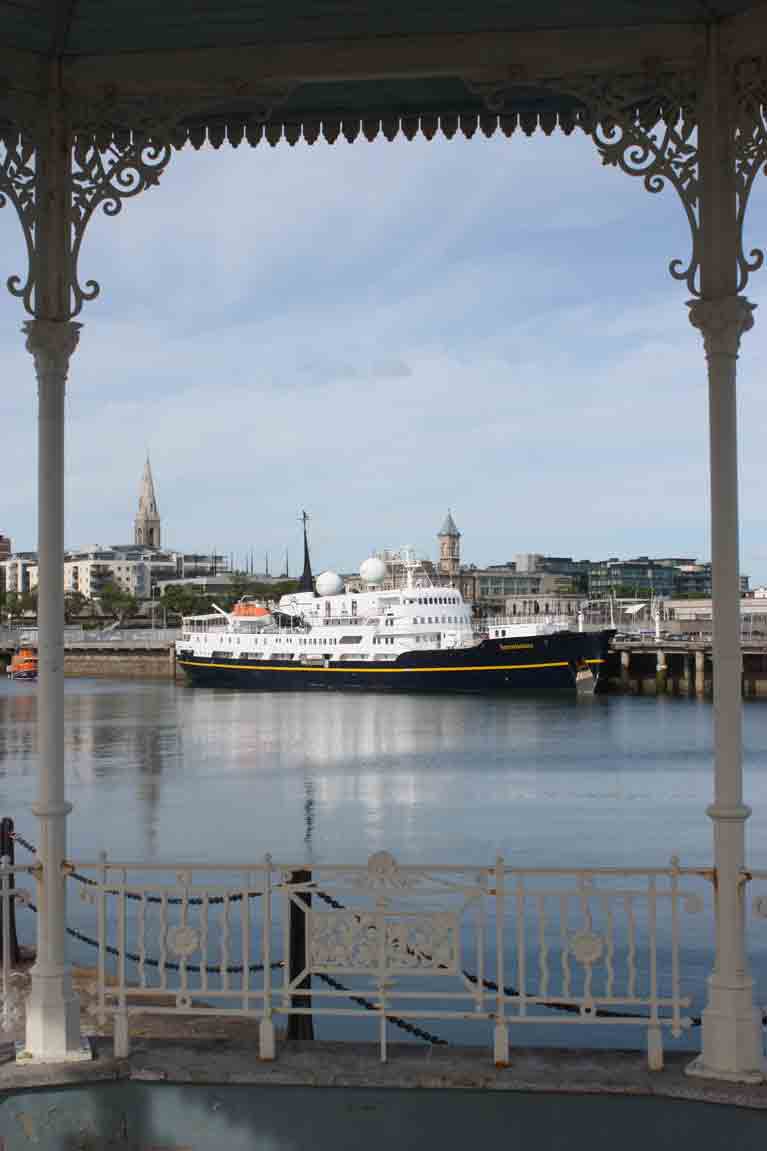 Cruise ship 'Serenissima' berthed at the Carlisle Pier in Dun Laoghaire
Cruise ship 'Serenissima' berthed at the Carlisle Pier in Dun Laoghaire
Dun Laoghaire Harbour Master Capt. Simon Coate today said that “Dun Laoghaire Harbour Company work hard to secure luxury ships of this kind to come and visit our harbour. The Serenissima which will stop off on her way around the “Gardens of the British Isles” is a charming vessel with a unique style. During a major refit the owners commissioned Swedish interior designers to create an 18th century influenced Gustavian style interior. The unique style and grandeur of this vessel certainly is in keeping with the unique aesthetics of our 200-year-old harbour, making Dun Laoghaire a sought-after port of call on her voyage.”
The ship is on a 12-day cruise of the “Gardens of the British Isles”. She left Portsmouth 7 days ago and has already made numerous stops along the English coast, has stopped off in Bantry Bay to visit Garnish Island and Waterford and now she is calling to Dun Laoghaire to visit Powerscourt Gardens. The ship will continue onto Wales, Northern Ireland and Scotland on route to her final destination in Oban in Scotland.



























